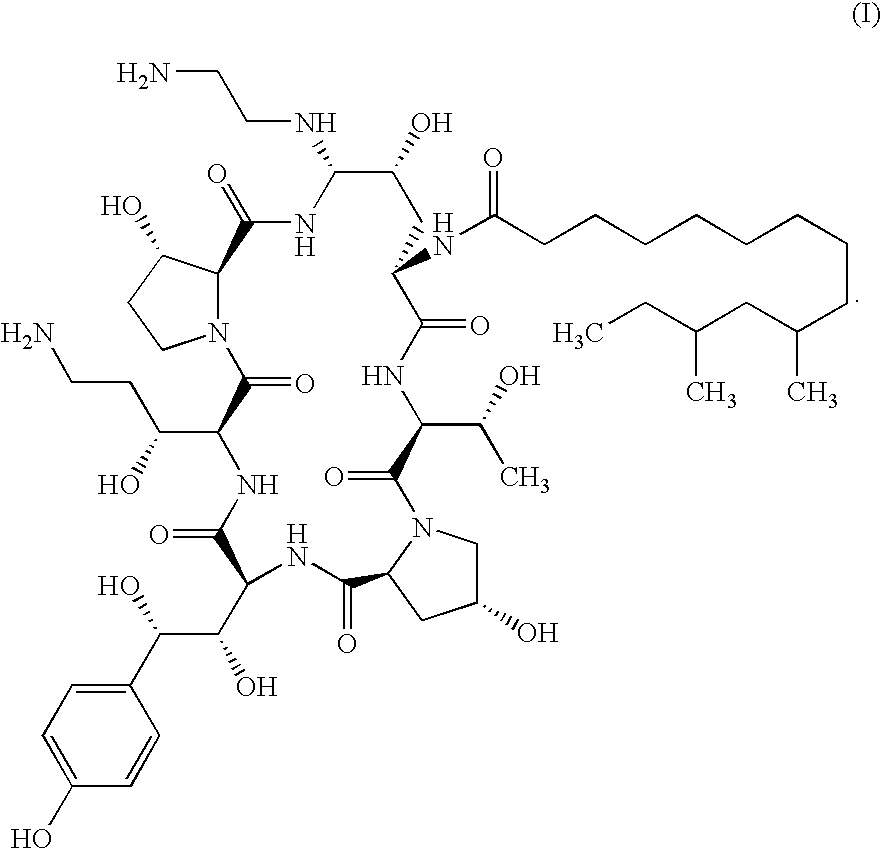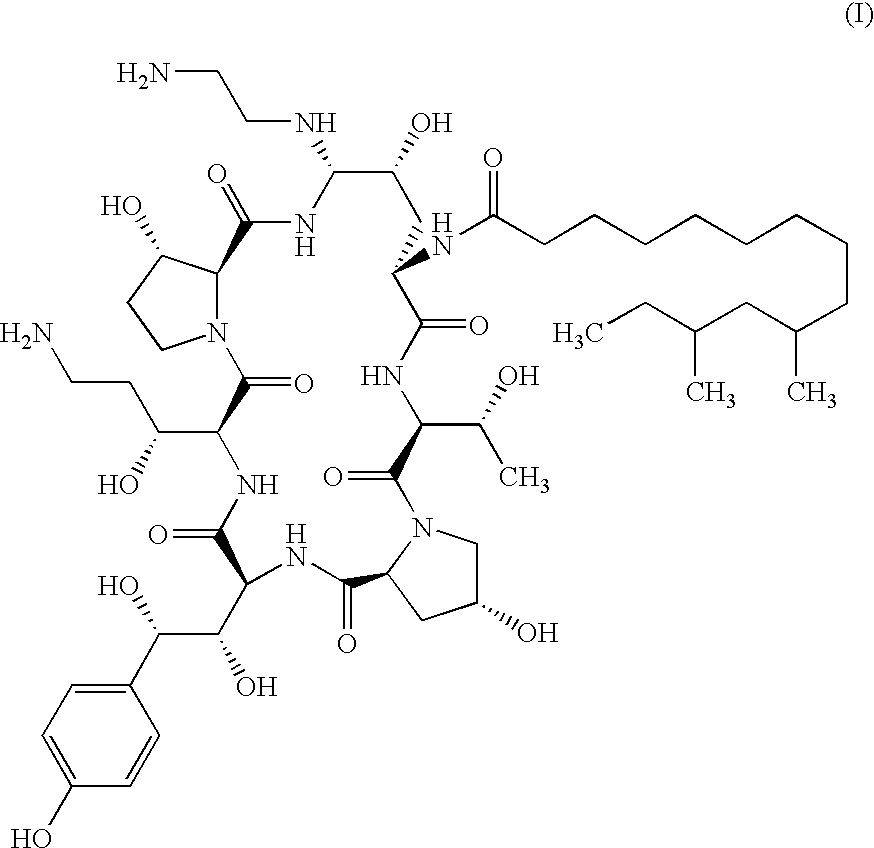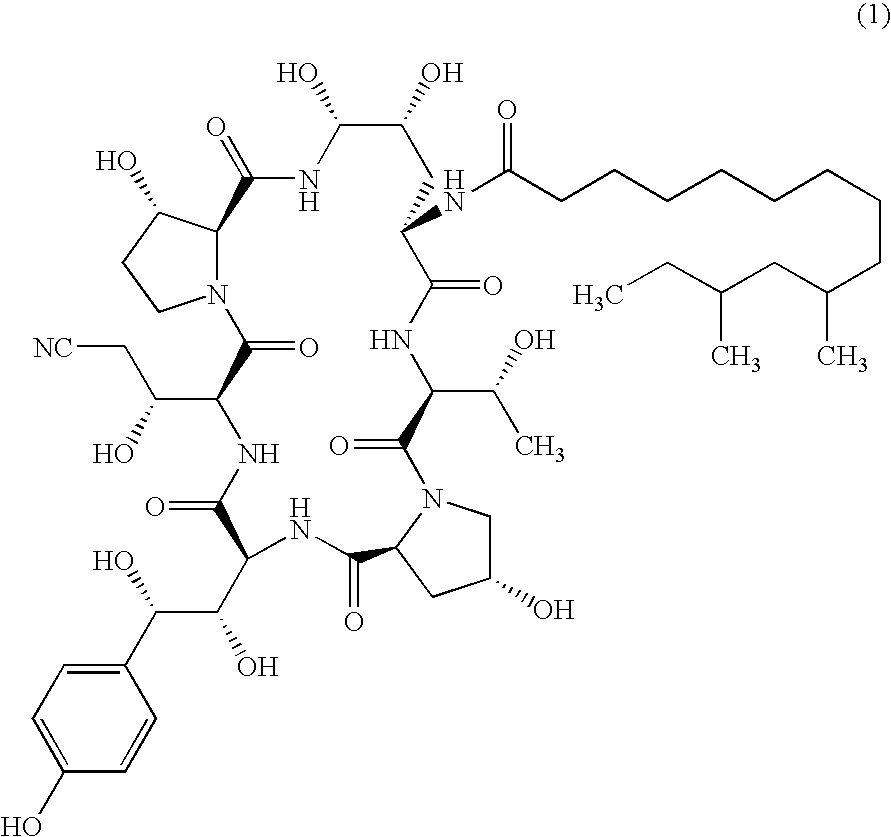Echinocandin process
a technology of echinocandin and echinocandin, which is applied in the direction of peptide/protein ingredients, immunoglobulins, peptides, etc., can solve the problem of formation of unwanted benzylic substituted derivatives of desired compounds
- Summary
- Abstract
- Description
- Claims
- Application Information
AI Technical Summary
Benefits of technology
Problems solved by technology
Method used
Image
Examples
example 1
[0054]
Synthesis of Compound 1
[0055]The amide, Compound 2, (1.0 g, 0.94 mmole) and phenylboronic acid (235 mg, 1.90 mmole) were added to dry tetrahydrofuran (10 mL) and the suspension was agitated until all solids dissolved (40 min). The resulting solution was dried to <20 mol % water: Compound 2 by passing the refluxate through a bed of molecular sieves (3A). A portion of the dried solution (1.0 mL) containing Compound 2 boronate (120 mg, 0.12 mmole) was transferred to a 25 mL flask where the tetrahydrofuran was removed under vacuum. The resulting solid was dissolved in 4.0 mL dry 1-methyl-2-pyrrolidinone and 0.45 mL dry N,N-dimethylformamide at ambient temperature. Cyanuric chloride (50 mg, 0.27 mmole) was then added at −13° C. with stirring. The reaction was aged for 2.5 hours at −13° C. followed by 18 hours at −23° C. HPLC analysis (210 nm) showed 3 area % Compound 2 and an 84% yield of Compound 1. Compound 3 was not detected by HPLC at this time nor was it observed after an addi...
example 2
[0056]
Synthesis and Isolation of Compound 5A (R═C(═O)NH2, R3=phenol)
[0057]Compound 4 (R═C(═O)NH2, 23.1 g, 21.7 mmole) and phenylboronic acid (5.72 g, 46.9 mmole) were added to dry acetonitrile (750 mL). The suspension was stirred at ambient temperature for 0.5 hours and then cooled to −6° C. where thiophenol (7.24 mL, 70.4 mmole) was added. Trifluoromethanesulfonic acid (6.23 mL, 70.4 mmole) was then added over 10 minutes while maintaining a temperature of −13° C. The reaction progress was monitored by HPLC until the ratio of starting material / product was 1:99 (2 hours). The chemical yield of phenylsulfide intermediate for the reaction was 95% as a 60:1 mixture of α- and β-diastereomers by HPLC assay. The undesired benzylic-substituted bis(phenylsulfide) derivative (Compound 5B, R═C(═O)NH2, R3=phenyl) and the undesired benzylic hydroxyl epimer (Compound 5C, R═C(═O)NH2, R3=phenyl) were present at 3.2 HPLC area % (210 nm) and 0.1 HPLC area % (210 nm), respectively. At 2.5 hours, a sol...
PUM
| Property | Measurement | Unit |
|---|---|---|
| temperature | aaaaa | aaaaa |
| temperature | aaaaa | aaaaa |
| temperature | aaaaa | aaaaa |
Abstract
Description
Claims
Application Information
 Login to View More
Login to View More - R&D
- Intellectual Property
- Life Sciences
- Materials
- Tech Scout
- Unparalleled Data Quality
- Higher Quality Content
- 60% Fewer Hallucinations
Browse by: Latest US Patents, China's latest patents, Technical Efficacy Thesaurus, Application Domain, Technology Topic, Popular Technical Reports.
© 2025 PatSnap. All rights reserved.Legal|Privacy policy|Modern Slavery Act Transparency Statement|Sitemap|About US| Contact US: help@patsnap.com



